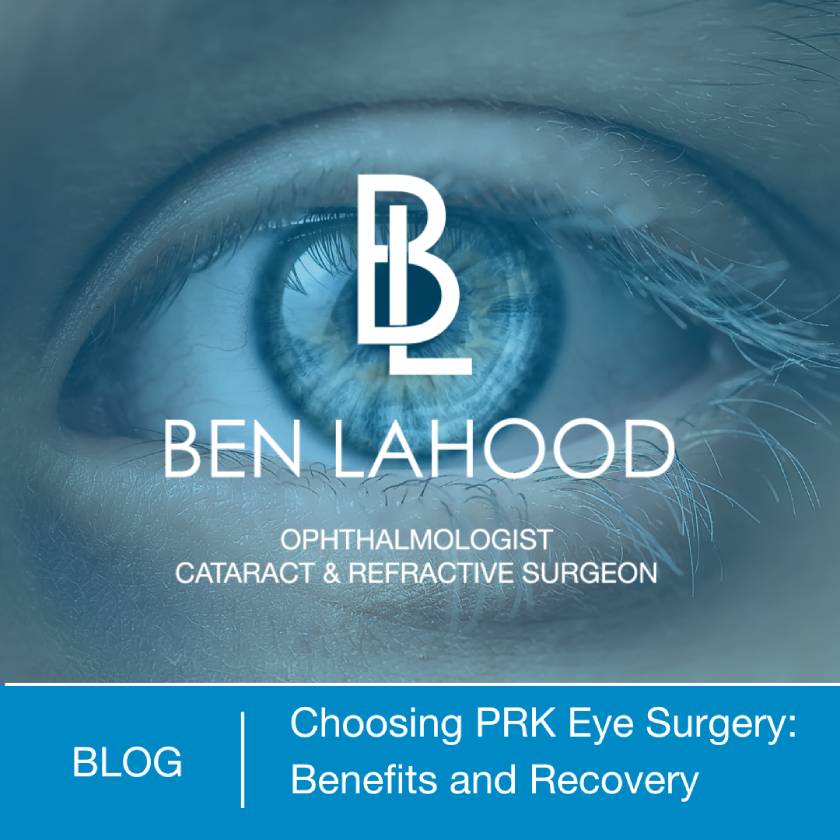
Choosing PRK Eye Surgery in Adelaide: Benefits and Recovery
Photorefractive Keratectomy (PRK) is one of the earliest and most trusted forms of laser vision correction. For those not suited to LASIK and SMILE® Pro, PRK eye surgery offers an excellent option. In this blog, we explore how PRK is performed, its benefits, the recovery, and what you can expect post-procedure.
How is PRK performed?
PRK is a type of laser eye surgery designed to correct vision issues like myopia, hyperopia, and astigmatism. Unlike SMILE® Pro, which creates a small incision and then involves the removal of a lenticle (a small piece of tissue) or LASIK, which involves creating a flap in the cornea, PRK involves gently removing the thin outer layer of the cornea (epithelium). A laser is then used to reshape the underlying corneal tissue. The eye then heals naturally over a few days, allowing the epithelium to regenerate. This approach makes PRK more suitable for patients with thinner corneas or certain corneal conditions.
Benefits of PRK Eye Surgery
Here are some of the most widely recognised PRK eye surgery benefits:
Suitable for Thin Corneas
PRK is often recommended for people with thin or irregular corneas where LASIK or SMILE® Pro may not be ideal.
- No Risk of Flap Complications: PRK avoids creating a corneal flap, which removes the risk of flap-related complications sometimes associated with LASIK.
- Proven Long-Term Results: PRK has been used globally for decades and provides stable and long-lasting vision correction. It is well-documented in clinical studies with high patient satisfaction.
- Reduced Dry Eye Symptoms: Since PRK affects the corneal nerves less than some other laser vision correction procedures, it typically leads to fewer long-term dry eye symptoms
- Safe for Active Lifestyles: PRK is a preferred option for individuals with physically demanding jobs or active lifestyles, where eye injuries or trauma could impact flap-based procedures.
PRK Eye Surgery Procedure
The procedure is generally performed under local anaesthesia and takes around 10 to 15 minutes per eye. The surgeon first removes the thin outer layer of the cornea. Then, a laser is applied to reshape the cornea based on the patient’s prescription. A soft contact lens is placed on the eye to aid healing and comfort during the initial recovery period. Patients return home the same day with instructions for rest and medications for eye care.
Recovery Process
PRK eye surgery recovery typically takes longer than LASIK or SMILE® Pro, but follows a steady healing pattern:
- Vision may be blurry in the first few days.
- Most patients notice significant improvement in vision within 1–2 weeks.
- Complete healing and stabilisation of vision may take a few months.
- Eye drops and medications are prescribed to reduce inflammation and prevent infection.
- Follow-up appointments ensure the eyes are healing correctly.
Patience in allowing the eyes to heal is important, as well as following your surgeon’s aftercare instructions can support a smooth recovery and help achieve the intended result.
What are the Pros and Cons of PRK Laser Eye Surgery?
Below are some key pros and cons to consider when evaluating PRK as a vision correction option.
Pros:
- Suitable for Thin Corneas: PRK is especially suitable for patients with thinner corneas who are not good candidates for LASIK or SMILE® Pro.
- No Corneal Flap: Because PRK avoids creating a flap in the cornea, there’s no risk of flap dislocation or flap-related issues post-surgery.
- Lower Risk of Dry Eye: Fewer corneal nerves are disturbed during PRK, potentially reducing the chance of chronic dry eyes.
- Good for Athletes or Physical Jobs: With no flap to worry about, PRK is ideal for those involved in contact sports or physical occupations.
- Long-Term Effectiveness: PRK has been in use since the 1990s and continues to show excellent long-term results with proper follow-up care.
Cons:
- Longer Recovery Time: Recovery is longer than that of LASIK and SMILE® Pro
- Initial Discomfort: Patients may experience initial eye discomfort, light sensitivity, or blurred vision for a few days after surgery as the eye is healing.
PRK Eye Surgery in Adelaide
If you’re considering PRK in Adelaide, it’s important to speak with an ophthalmologist that specialises in refractive surgery, who regularly performs the procedure and takes the time to assess whether it suits your eye health and lifestyle.
Dr Ben LaHood offers laser vision correction, including PRK, with patient-focused and individualised care from your initial consultation through to post-procedure follow-up.
If you would like to understand your suitability for laser vision correction, please take the Online Eye Suitability Test, or if you would like to seek a referral to his care, please contact him here.




